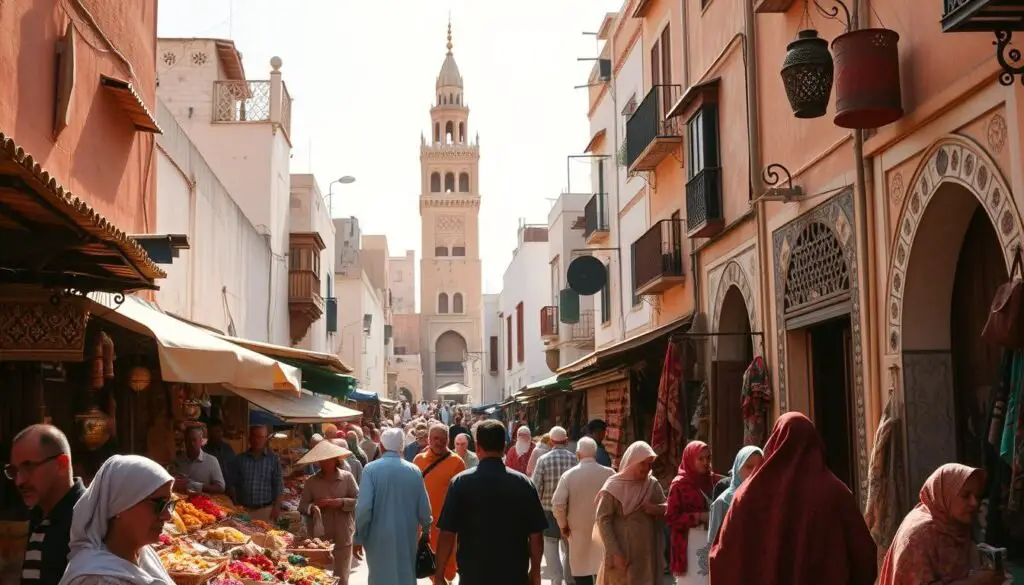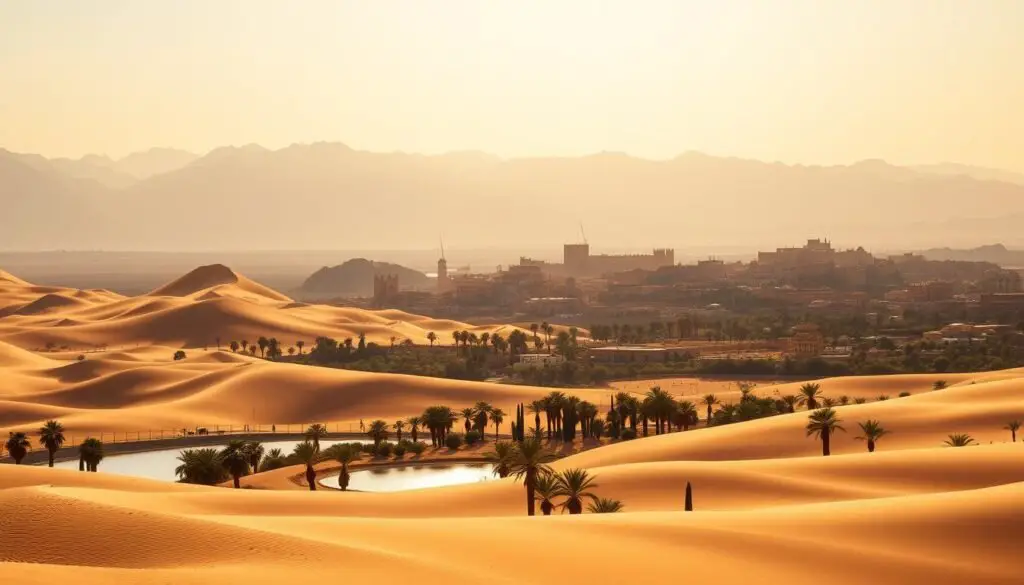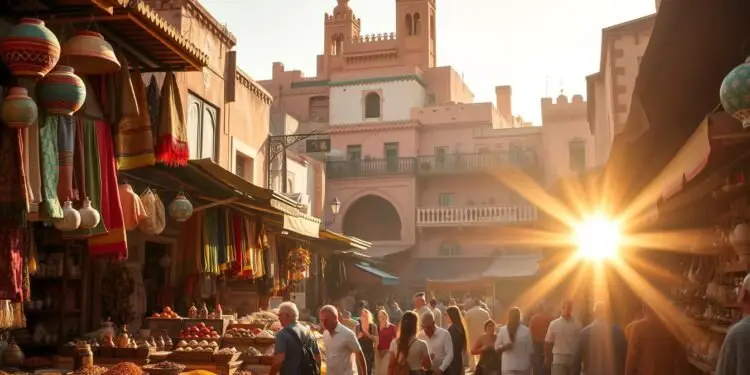Did you know that Morocco holds a unique place in American history? This North African country is more than just a destination; it’s a crossroads of cultures, blending African, Arab, and European influences into a vibrant tapestry. From its imperial cities to the vast Sahara Desert, Morocco offers a wealth of experiences that captivate travelers from around the world.
Home to UNESCO World Heritage Sites like Ait Benhaddou and the Arganeraie Biosphere Reserve, Morocco is a land of contrasts. Its cities, such as Marrakech and Fez, are steeped in history, while its modern marvels like the Hassan II Mosque showcase architectural brilliance. Whether you’re exploring bustling souks or trekking the Atlas Mountains, every corner of this country reveals its beauty and secrets.
In this article, we’ll uncover 10 surprising facts that highlight Morocco’s rich history, culture, and geography. From its role in global trade to its unique traditions, prepare to see this travel gem in a whole new light.
Key Takeaways
- Morocco blends African, Arab, and European influences into a unique cultural experience.
- The country is home to UNESCO World Heritage Sites and stunning natural landscapes.
- Imperial cities like Marrakech and Fez are historical anchors of Moroccan heritage.
- Morocco is the world’s largest exporter of argan oil, a product of its Berber culture.
- The Hassan II Mosque in Casablanca is one of the largest mosques globally.
- Morocco’s strategic location has made it a crossroads of civilizations throughout history.
- Lesser-known facts include its role in American history and unique cultural traditions.
Amazing Facts About Morocco You Never Knew
From diplomacy to natural resources, Morocco has left an indelible mark on the world. This North African country is not only a cultural hub but also a key player in global history and economy.
Morocco’s Historic Recognition of American Independence
In 1777, Morocco became the first state to recognize U.S. independence. This bold move established a diplomatic relationship that continues to this day. Morocco’s foresight during the 18th century highlights its strategic importance on the global stage.

This historic gesture solidified Morocco’s role as a key ally in the world. It also reflects the country’s long-standing tradition of fostering international relationships.
The Global Dominance of Moroccan Argan Oil
Morocco is home to the Arganeraie Biosphere Reserve, where argan trees thrive. These trees produce argan oil, a product that has gained worldwide acclaim. Nearly 99% of the global supply comes from this region.
Berber cooperatives play a vital role in argan oil production. These groups support local communities while preserving traditional techniques. The Amazigh people, who make up a significant portion of Morocco’s population, are central to this process.
Argan oil is versatile, used both in traditional cooking and modern cosmetics. Its popularity has turned it into a symbol of Morocco’s natural wealth. The argan forests, recognized by UNESCO, further underscore their ecological and cultural importance.
Cultural Marvels of Morocco
Morocco’s cultural heritage is a vibrant blend of traditions that have shaped its identity over centuries. From its people to its cities, the culture of this North African nation is a reflection of its rich history and diverse influences.
The Significance of Couscous in Moroccan Tradition
Couscous, known locally as K’seksu, has been a staple of Moroccan cuisine since the 7th century. It is more than just a dish; it is a symbol of unity and community. During festivals and family gatherings, women often lead the preparation of couscous, turning it into a communal ritual.
In 2020, couscous was designated as a UNESCO Intangible Cultural Heritage. This recognition highlights its importance not only as a meal but also as a cultural tradition that has stood the test of time.
The Berber Influence on Modern Morocco
The Berber people, or Amazigh, make up around 40% of Morocco’s population. Their languages, including Tashelhit and Tamazight, are co-official with Arabic. This linguistic diversity is a testament to their enduring influence.
Berber contributions extend to art, music, and even place names like the Atlas Mountains. Their nomadic traditions have also inspired modern ecotourism initiatives, showcasing the harmony between culture and nature.
Today, the Tifinagh script, used by the Berber people, is experiencing a resurgence. It can be seen in modern signage and educational materials, preserving their heritage for future generations.
Morocco’s Unique Geographic and Architectural Wonders
From towering minarets to snow-capped peaks, Morocco’s geography is as diverse as its culture. This North African country is home to some of the most iconic landmarks in the world, blending tradition with innovation. Whether you’re exploring its bustling city centers or trekking through its rugged landscapes, Morocco offers a trip like no other.

Hassan II Mosque: A Modern Architectural Feat
The Hassan II Mosque in Casablanca is a masterpiece of design. Its 689-foot minaret is one of the tallest in the world, and the mosque can accommodate up to 80,000 worshippers. What sets it apart is its hybrid design, featuring traditional zellige tiles alongside modern elements like a retractable roof and glass floors.
This mosque is also one of the few in Morocco open to non-Muslim visitors. Guided tours allow travelers to appreciate its intricate details and learn about its cultural significance. The Hassan II Mosque is a symbol of Morocco’s ability to blend its rich heritage with contemporary innovation.
Jebel Toubkal: North Africa’s Highest Peak
Jebel Toubkal, standing at 13,665 feet, is the highest peak in North Africa. Located in the High Atlas Mountains, it attracts hikers from around the globe. The ascent requires local guides, ensuring safety and providing insights into the region’s Berber culture.
Trekking routes vary by season, with snow-covered trails in winter and warmer paths in summer. Along the way, visitors can experience homestays in Berber villages, promoting sustainable tourism. The High Atlas Mountains are not just a natural wonder but also a gateway to understanding Morocco’s diverse traditions.
For U.S. readers, Morocco’s size—172,414 square miles—is comparable to California. This vastness encompasses everything from the Sahara desert to lush valleys, making it a beauty to explore. Whether you’re drawn to its architectural marvels or its natural places, Morocco promises an unforgettable journey.
Surprising Traditions and Customs in Morocco
Morocco’s traditions offer a fascinating glimpse into its cultural depth. From symbolic gestures to communal rituals, these customs reflect the country’s rich heritage and unique identity.
In Moroccan culture, the liver, not the heart, symbolizes love. Expressions like “Lkbida diali” (my liver) are commonly used in poetry and daily conversations. This tradition highlights the deep emotional connections valued by the people.
Dining etiquette in Morocco is steeped in respect and tradition. Using the left hand during meals is considered taboo, while the right hand is used for gestures and eating. Communal tagine sharing and the ritual of serving mint tea are central to Moroccan hospitality.
Throne Day, celebrated on July 30, honors King Mohammed VI. This national holiday includes parades, music, and festivities, showcasing the state’s unity and pride. Morocco also observes three New Year celebrations: Gregorian, Amazigh, and Islamic, each reflecting its diverse cultural influences.
Oukaimeden Ski Resort, located in the Atlas Mountains, defies the Sahara Desert stereotype. It attracts tourism with its snow-covered slopes, offering a unique experience in this North African country.
These traditions and customs provide a window into Morocco’s vibrant culture and its enduring connection to time-honored practices. Whether through symbolic expressions or communal celebrations, Morocco continues to captivate visitors with its unique way of life.
Conclusion
Morocco seamlessly merges its ancient roots with modern advancements, creating a unique travel experience. From the imperial cities of Marrakech and Fez to the towering Atlas Mountains, this country offers a blend of history and natural beauty. UNESCO sites like Volubilis and the Arganeraie Biosphere Reserve showcase its cultural and ecological richness.
For those seeking sustainable tourism, Morocco provides opportunities like argan oil cooperatives and Berber-guided treks. The country is also making strides in renewable energy, with projects like the Tarfaya Wind Farm leading the way.
Plan your trip to explore Morocco’s diverse landscapes and immerse yourself in its vibrant traditions. Whether you’re wandering through ancient medinas or marveling at modern architectural feats, this North African gem promises an unforgettable journey.
FAQ
What is the significance of Morocco’s recognition of American independence?
Morocco was the first country to recognize American independence in 1777, establishing a long-standing diplomatic relationship between the two nations.
Why is Moroccan argan oil so globally renowned?
Moroccan argan oil is prized for its unique production process and versatile uses in cosmetics and cooking, making it a sought-after product worldwide.
How important is couscous in Moroccan culture?
Couscous is a staple dish in Moroccan cuisine, symbolizing hospitality and tradition, often served during family gatherings and celebrations.
What role do the Berbers play in Moroccan society?
The Berbers, indigenous to North Africa, have deeply influenced Morocco’s language, art, and cultural heritage, shaping its modern identity.
What makes the Hassan II Mosque a modern architectural marvel?
The Hassan II Mosque in Casablanca is one of the largest mosques globally, featuring intricate designs and a retractable roof, blending traditional and modern architecture.
Where is Jebel Toubkal located, and why is it significant?
Jebel Toubkal, located in the Atlas Mountains, is North Africa’s highest peak, attracting hikers and adventurers for its stunning views and challenging trails.
What are some unique traditions in Morocco?
Morocco is known for its vibrant festivals, tea ceremonies, and henna art, reflecting its rich cultural diversity and historical roots.




